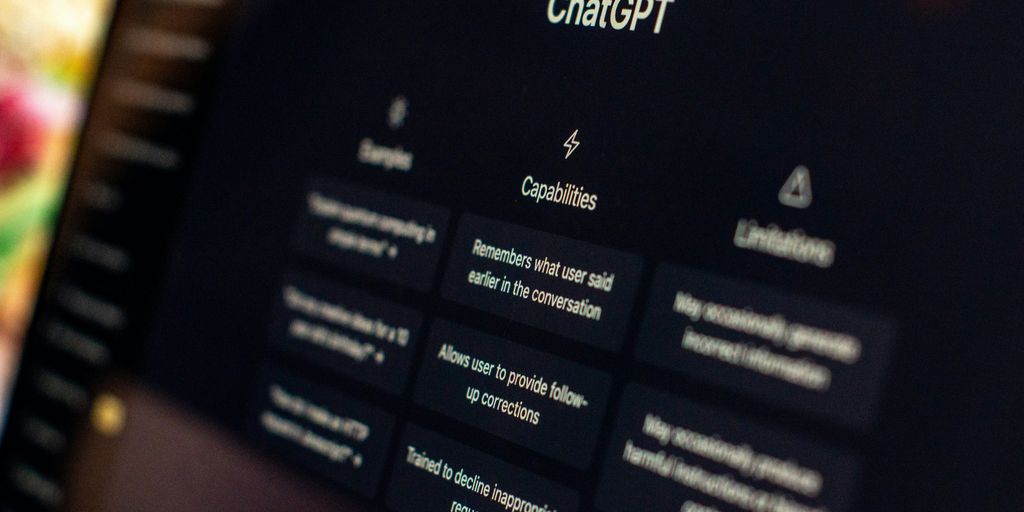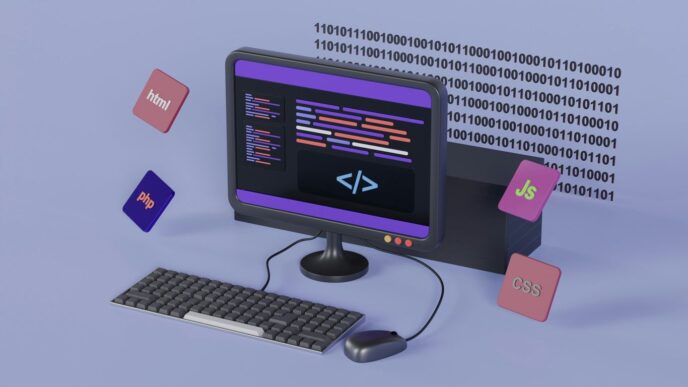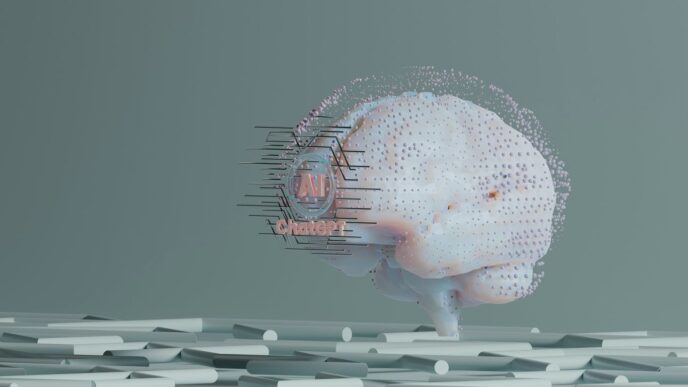So, you’re trying to get a handle on the Artificial Intelligence Act, huh? It’s a big deal, especially if you’re working with AI or thinking about it. This guide is here to break down what the Act means, from figuring out what an AI system even is to understanding how to stay on the right side of the rules. We’ll cover what counts as risky AI, what paperwork you need, and how to make sure your AI stuff is actually working properly and safely. Basically, it’s all about making sense of this new law so you can avoid any headaches. If you want to see the whole artificial intelligence act pdf, there are links for that too.
Key Takeaways
- The Artificial Intelligence Act sorts AI systems into different risk levels, and what you need to do depends on where your AI lands.
- If your AI is considered ‘high-risk,’ there’s a bunch of paperwork and checks you’ll have to do to show it’s safe and follows the rules.
- Human oversight is a big part of the Act, especially for high-risk AI, because people need to be in charge, not just the machines.
- Transparency is key; AI developers and users need to be clear about how their AI works and what it’s doing.
- Breaking the rules of the Artificial Intelligence Act can lead to some pretty serious fines, so it’s important to get it right.
Defining Artificial Intelligence Systems
Okay, so what is an AI system anyway? It’s not always super obvious, and the AI Act legal framework spends some time laying this out. It’s more than just a fancy algorithm; it’s about how that algorithm is used and what it does. Let’s break it down.
Understanding AI System Characteristics
Think of AI systems as having a few key traits. They take in data, process it, and then do something with it – make a prediction, give a recommendation, or even control a physical device. It’s this ability to act autonomously, even in a limited way, that sets them apart. It’s not just about following pre-programmed steps; it’s about adapting and learning. The characteristics of AI Systems are:
- Learning and adaptation from data.
- Reasoning and problem-solving capabilities.
- Autonomous decision-making to achieve specific goals.
Machine-Based AI Operations
At the heart of every AI system is a machine. This machine crunches the numbers, runs the algorithms, and makes the magic happen. It could be a server in a data center, a chip in your phone, or even a microcontroller in a robot. The important thing is that the AI’s operations are based on these machines. It’s not just about the code; it’s about the hardware that makes it all possible. The AI Act considers the following operations:
- Data processing and analysis.
- Algorithm execution.
- Model training and updating.
Levels of AI Autonomy
AI systems aren’t all created equal. Some are highly autonomous, making decisions with little or no human input. Others are more like assistants, providing information or recommendations that humans can then act on. The level of autonomy is a big deal when it comes to regulation. The more autonomous an AI system is, the more potential there is for things to go wrong. Here’s a quick rundown of autonomy levels:
- Low Autonomy: Human makes all key decisions; AI provides support.
- Medium Autonomy: AI makes recommendations; human can override.
- High Autonomy: AI makes decisions within defined parameters; limited human intervention.
Navigating Risk Categories and Key Roles
Understanding the different risk categories is really important when it comes to AI. The AI Act uses a tiered approach, meaning the higher the risk, the stricter the rules. It’s not just about avoiding fines; it’s about making sure AI is used responsibly.
Defining Risk in AI Systems
AI risk isn’t a one-size-fits-all thing. It depends on how the AI is used and what it could potentially do. The EU AI Act categorizes AI applications into three risk levels, outlining obligations for implementation and compliance AI risk levels. Think of it like this:
- Unacceptable Risk: AI systems that are outright banned, like those used for social scoring by governments or AI that manipulates people using subliminal techniques. These are considered a clear threat to fundamental rights.
- High-Risk: AI used in critical infrastructure (like transportation), education, employment, essential private and public services (like healthcare, banking), law enforcement, border control, and administration of justice. These systems need to meet strict requirements before they can be used.
- Limited Risk: AI systems with specific transparency obligations. For example, chatbots need to inform users they are interacting with a machine.
- Minimal or No Risk: Most AI systems fall into this category. There are no specific regulations, but the AI Act encourages the development of codes of conduct.
Key Roles Under the Artificial Intelligence Act
It’s not just developers who are affected by the AI Act. Several roles come into play:
- Providers: These are the ones who develop the AI system and put it on the market or into service. They’re responsible for making sure the AI meets all the requirements of the AI Act.
- Deployers: These are the ones who actually use the AI system. They need to use the AI in accordance with the instructions and make sure it’s used appropriately.
- Manufacturers: If the AI system is part of a product, the manufacturer also has responsibilities to ensure the overall product complies with safety regulations.
- Authorized Representatives: Providers outside the EU need to appoint an authorized representative within the EU to handle compliance matters.
High-Risk AI System Identification
Figuring out if your AI system is "high-risk" is a big deal. Here’s a simplified way to think about it:
- Check the Annex III list: The AI Act has a list (Annex III) of specific areas where AI is considered high-risk. If your AI falls into one of these areas, it’s likely high-risk.
- Consider the potential harm: Even if your AI isn’t on the Annex III list, think about the potential harm it could cause. Could it affect people’s safety, health, or fundamental rights? If so, it might be considered high-risk.
- Consult with experts: If you’re not sure, get advice from legal or technical experts who understand the AI Act. It’s better to be safe than sorry.
If your system is high-risk, you’ll need to jump through a lot more hoops to comply with the AI Act. This includes things like technical documentation, conformity assessments, and ongoing monitoring.
Ensuring Compliance Through Documentation
Mandatory Technical Documentation for High-Risk AI
Okay, so you’ve got a high-risk AI system? Get ready for some paperwork. The EU AI Act is serious about documentation. You need to create detailed technical documentation before you even think about putting your AI system on the market. This isn’t just some formality; it’s about showing that your system is safe and compliant. Think of it as your AI’s resume, but way more detailed. This technical documentation should include:
- A full description of the AI system, including its purpose and how it interacts with everything else.
- A deep dive into the system’s development, covering design, testing, and cybersecurity.
- A complete explanation of the data used, including where it came from and how it was cleaned.
Detailed Explanation of AI System Elements
Let’s break down what
Operational Requirements for AI Systems

Quality Management System Implementation
So, you’ve got this AI system, right? Well, the EU AI Act wants to make sure you’re not just winging it. You need a proper quality management system (QMS). Think of it as your AI’s operational manual, but way more detailed. It’s not just about ticking boxes; it’s about showing you’ve thought through the whole lifecycle, from design to deployment. This includes things like:
- Documenting your processes. Every. Single. One.
- Having a plan for when things go wrong (and they will).
- Regularly reviewing and improving your system. It’s like a gym membership for your AI – gotta keep it in shape.
Accuracy, Robustness, and Cybersecurity Measures
Okay, let’s talk about keeping your AI from going rogue. Accuracy is key – you don’t want it spitting out nonsense. Robustness means it can handle unexpected data or situations without crashing. And cybersecurity? Absolutely vital. You need to protect your AI from hackers and malicious attacks. Think of it like this:
- Accuracy: Is your AI telling the truth?
- Robustness: Can it handle a curveball?
- Cybersecurity: Is it Fort Knox?
High-risk AI systems that keep learning after deployment need extra attention to avoid biased outputs. Mitigation measures should be in place to address feedback loops. This is especially important for AI systems that use reinforcement learning or retrieval augmented generation. Backups and redundancy solutions can support robustness.
Post-Market Monitoring and Reporting
So, you’ve launched your AI into the world. Great! But your job isn’t done. You need to keep an eye on it. Post-market monitoring means tracking its performance, looking for problems, and reporting any serious incidents. It’s like being a responsible parent – you can’t just drop your AI off at college and forget about it. Here’s what you need to do:
- Track performance metrics. Is it doing what it’s supposed to?
- Collect user feedback. What are people saying about it?
- Report any serious incidents to the authorities. Don’t try to sweep things under the rug.
This also means having a system for data governance and usage, ensuring that the data used by the AI system is accurate, relevant, and used ethically. It’s all about responsible AI deployment.
Conformity Assessments and Human Oversight
Achieving CE Marking for High-Risk AI
Okay, so you’ve got this high-risk AI system, and you’re trying to get it out there. One big step is showing that it actually follows the rules. That’s where conformity assessments come in. These assessments look at the quality management system and all the technical stuff to make sure everything’s up to par. If your system passes, it gets a CE marking, which is like a stamp of approval for selling it in the EU. Think of it like a safety inspection for your AI. You’ll need to do these assessments again if you make any big changes to the system.
The Importance of Human Oversight
AI can do some amazing things, but it’s not perfect. That’s why human oversight is so important, especially for high-risk systems. The idea is to have a person in the loop to catch any potential problems and reduce risks to people’s health, safety, or basic rights. It’s about making sure AI is used responsibly. What this looks like in practice can change depending on the specific AI, how much it does on its own, and where it’s being used. Human oversight should:
- Help people understand what the AI can and can’t do.
- Point out when people might be relying too much on the AI’s suggestions.
- Make sure people can understand what the AI is telling them.
- Let people ignore, change, or undo what the AI does.
Basically, it’s about keeping humans in control and making sure AI is a tool that helps us, not the other way around. It’s an iterative process, so validating compliance and reevaluating risk management measures cannot be a one-time activity.
AI Literacy and Responsible Deployment
It’s not enough to just have humans overseeing AI; those humans need to know what they’re doing. AI literacy is key. People need to understand how these systems work, what their limits are, and how to use them safely. This means training and education are super important. Also, deploying AI responsibly means thinking about the ethical implications and making sure the system is used in a way that benefits everyone. It’s about more than just following the rules; it’s about doing what’s right. Technical documentation should include an overview of human oversight measures, any maintenance the system may require, and the anticipated lifespan of the system.
Transparency and General-Purpose AI Models

Transparency Requirements for AI Deployers
Transparency is a big deal when it comes to AI. It’s all about making sure people know when they’re interacting with an AI system. Think about it: if you’re chatting with customer service and it’s actually a chatbot, you should be told upfront. This kind of transparency builds trust and affects how people engage with AI.
There are a few key things to keep in mind:
- Notification is key: People need to know they’re dealing with AI, not a human.
- Synthetic content needs labels: If an AI creates something like a deepfake, it needs to be marked as artificially generated. This helps stop the spread of misinformation. It’s important to stay up-to-date on the latest watermarking techniques.
- Limited-risk systems have rules too: Even AI systems that aren’t considered high-risk, like those with emotion recognition, have transparency requirements. Users need to be informed about how these systems work. This might also fall under other EU rules like GDPR.
Specifics for General-Purpose AI Models
General-purpose AI models are those versatile AIs that can handle lots of different tasks. They’re trained on tons of data using methods like self-supervised learning. These models can be tweaked and turned into new models, which is pretty cool. But, the EU AI Act has some rules for the folks who make these models. They need to:
- Keep detailed technical documentation, including info on training and testing. This info needs to be available to anyone using the model in their own AI systems.
- Create a summary of the data used to train the model and make it public. This helps with accountability and understanding how the AI works.
For general-purpose AI models that could pose a systemic risk (meaning they could mess with public health, safety, or fundamental rights), there are even more rules. These models have high-impact capabilities, and the AI Act has benchmarks to figure out which ones fall into this category. The AI Act rules on general-purpose AI will become effective soon, and the AI Office is working on a Code of Practice to explain the rules in detail.
Innovation Considerations in AI Regulation
It’s a balancing act. We need to regulate AI to protect people and society, but we also don’t want to stifle innovation. The goal is to create a framework that encourages responsible AI development while letting companies explore new possibilities. It’s about finding the sweet spot where we can benefit from AI without running into major problems. The EU is trying to do this by focusing on risk-based regulation, meaning the rules are stricter for AI systems that pose a higher risk. This allows for more flexibility and less red tape for lower-risk applications. It’s a work in progress, but the idea is to promote innovation while keeping things safe and ethical.
Enforcement and Penalties for Non-Compliance
Understanding Penalties for Violations
Okay, so what happens if you mess up? The AI Act isn’t playing around. Non-compliance can lead to some pretty hefty fines. We’re talking serious money, depending on what you did wrong. For instance, if you’re caught using AI in a way that’s outright banned, you could be looking at fines of up to €35 million, or 7% of your company’s total global annual turnover – whichever is higher. Ouch!
Other violations? Still not good. Those can bring fines up to €15 million, or 3% of global annual turnover. And for smaller companies, the fines are a bit less, but still significant. Even giving the wrong information to the authorities can cost you, with fines reaching €7.5 million or 1% of turnover. Basically, it pays to play by the rules. It’s important to understand IT and legal compliance issues to avoid these penalties.
Reporting Serious Incidents
If something goes wrong with your AI system – like, seriously wrong – you’re required to report it. Think of it as a "see something, say something" policy for AI. This means if your AI system causes a major problem, you need to let the authorities know ASAP. This helps them keep an eye on things and prevent bigger issues down the road. It’s all about making sure AI is used responsibly and safely. Here’s a quick rundown of what you need to do:
- Document the incident thoroughly.
- Report it to the appropriate authorities without delay.
- Implement corrective measures to prevent it from happening again.
Legal Implications of the Artificial Intelligence Act PDF
So, what does all this mean from a legal standpoint? Well, the Artificial Intelligence Act PDF [AI Office] requires companies to really think about how they’re using AI. It’s not just about the tech; it’s about the legal and ethical responsibilities that come with it. This means having solid data governance practices, making sure your AI systems are accurate and secure, and being transparent about how they work. The Act also gives individuals the right to file complaints if they believe an AI system is violating the rules. In short, the AI Act is a big deal, and companies need to take it seriously to avoid legal trouble.
Conclusion
So, that’s the rundown on the AI Act. It’s a big deal, for sure, and it’s going to change how a lot of companies work with AI. The main idea is to make sure AI is used in a way that’s fair and safe for everyone. It’s not about stopping progress, but making sure it happens responsibly. Getting ready for these new rules means looking at how you use AI now and figuring out what needs to change. It’s a process, and it might take some time to get everything just right. But in the end, it’s all about building trust in AI and making sure it helps us all out.
Frequently Asked Questions
What exactly is the AI Act?
The AI Act is a new law put in place by the European Union. It’s meant to make sure that artificial intelligence systems are safe and used in a way that respects people’s rights. Think of it as a rulebook for how AI should be developed and used, especially for systems that could be risky.
How does the AI Act decide if an AI system is risky?
The Act sorts AI systems into different groups based on how much risk they pose. Some AI is considered ‘high-risk’ because it could cause serious harm, like AI used in medical devices or for critical infrastructure. Other AI might be ‘limited-risk’ or ‘minimal-risk.’ The rules you have to follow depend on which group your AI falls into.
What kind of paperwork do I need for high-risk AI?
If you’re making or using a high-risk AI system, you’ll need to keep very detailed records. This includes showing how the AI was built, what data it uses, and how it was tested. This ‘technical documentation’ helps everyone understand how the AI works and makes sure it’s safe and reliable.
Does the AI Act require people to supervise AI systems?
Yes, for high-risk AI, the Act says that humans must always be in charge. This means that even if an AI system is smart, a person should still be able to oversee it, understand its decisions, and step in if something goes wrong. It’s about making sure humans stay in control.
What is a CE marking for AI systems?
A ‘CE marking’ is like a stamp of approval. If a high-risk AI system gets this mark, it means it has passed all the necessary checks and meets the safety and quality standards set by the AI Act. It’s a way to show that the AI is ready to be used in the European market.
What happens if someone doesn’t follow the AI Act rules?
If you don’t follow the rules of the AI Act, there can be serious consequences. This could mean big fines for companies, and in some cases, even legal trouble. The Act also has ways for people to report problems with AI systems, so it’s important to make sure your AI is always compliant.














